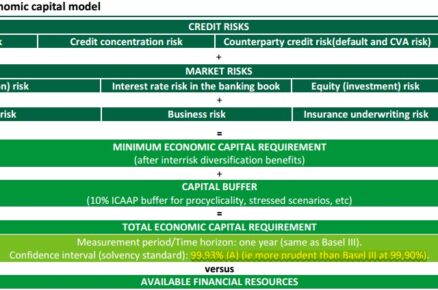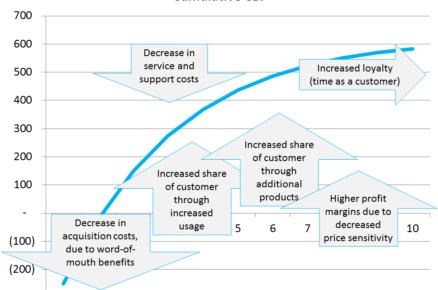Simple CLV Formula
There are two main approaches to calculating customer lifetime value. This article discusses the simple approach to calculating customer lifetime value – which is appropriate to use when customer profit contribution to each year are relatively flat. It is also a good idea to review the article on the full customer lifetime value formula, also available on this website.
The simple customer lifetime value formula
The simple customer lifetime value formula is:
Annual profit contribution per customer X
Average number of years that they remain a customer
Less the initial cost of customer acquisition
An example of the simple customer lifetime value formula
Let’s assume the following:
- Profit generated by the customer each year = $1,000
- Number of years that they are a customer of the brand = 5 years
- Cost to acquire the customer = $2,000
The customer lifetime value of this customer would be:
$1,000 (annual profit from the customer) X
5 (number of years that they are a customer) less
$2,000 (acquisition cost) = $3,000 = CLV.
That is, $1,000 X 5 – $2,000 = $3,000.
A more detailed example of the simple CLV formula
Let’s look at the same formula to calculate customer lifetime value, the building a little bit more complexity by changing the initial assumptions as follows:
- annual revenue per average customer is $2,000 per annum
- product costs associated with the average customer’s purchases is $500 per year
- the firm also spends $100 a year per customer to provide customer service
- annual retention rate (loyalty rate) is 80%
- average costs to acquire a new customer are $1,000
In this example, we have a similar challenge to the example above, but the information is not presented as neatly and we need to modify some of the above data to feed into the customer lifetime value formula.
Our first step here is to calculate the average annual profit per customer – which is determined by deducting the two sets of costs (product costs and service costs) from the annual revenue. In this case, it is $2000 – $500 – $100 = $1,400.
We have acquisition costs provided for us ($1,000), but unfortunately we do not have the average lifetime of the customer in years – we only have the annual retention rate. This will be a common situation in a workplace, as it is relatively easy from a customer database to calculate retention rates. So our challenge is now to convert a retention rate to the average number of years that the customer will deal with the firm.
There is another article on converting retention (loyalty) rates to an average customer lifetime period. However, it is quite easy to calculate the customer lifetime in years from a retention rate, as follows:
100% divided by (100% minus the annual retention rate)
OR (1 / 1- annual retention rate)
So in this example of an 80% loyalty rate, the average customer lifetime would be:
100% / (100% -80%) =
100% / 20% = 5 years average customer lifetime period
Now we have all the inputs into the simple customer lifetime value formula, we can then calculate CLV as:
CLV = $1,400 (profit) X 5 (years) – $1,000 (acquisition) = $6,000
When to Use the Simple CLV Formula
There are two customer lifetime value (CLV) formulas provided on this website. This article discusses when it is appropriate to use the simple customer lifetime value formula.
You may also want to refer to the limitations of using this formula and you should also review the article on main customer lifetime value formula. Please note there are also a free Excel spreadsheet template available on this website that allows you to calculate customer lifetime value.
When to use the simple CLV formula
The simple CLV formula is quite appropriate to use when:
- Retention rates of customers are relatively low (say 50% or less) – which means of most of the customer profit contribution is received in the first few years
- Profit contributions from customers are relatively flat over time – that is, there is no significant changes in the average customer profitability with time
- The data inputs to the model are mainly based upon assumptions rather than historical customer data (with the customer lifetime value just being a rough estimate)
- Only a ballpark customer lifetime value estimate is needed – rather than a precise measure
- The firm is uninterested or uncomfortable in using discount rates
- Customers are highly profitable and recover their acquisition costs within the first year
How accurate is the simple CLV formula?
In many cases, the simple customer lifetime value formula is quite adequate and will provide a reasonable estimate as compared to the main CLV formula (which is available on the free Excel spreadsheet template on this website).
There are two key differences between the simple CLV and the main CLV formulas are:
- The simple customer lifetime value formula assumes that all the data inputs (customer revenue/costs and retention rate) remains consistent over time, and
- The simple CLV formula does not use a discount rate.
Let’s compare the calculations of both CLV formulas using an example as follows:
A firm has an average acquisition cost of $500, average customer annual profit contribution is $800 – which increases by 5% per year, and the firm’s retention rate is 60% (equivalent to 2.5 years average lifetime). In this case, a 10% discount rate is used in the main CLV formula.
Using the simple CLV formula:
- CLV = $840 (customer profit contribution – see note below) X
- 2.5 (average customer lifetime in years) –
- $500 (Customer acquisition cost)
- CLV = $2,000 – $500 = $1,600
NOTE: In this case, we have used $840 in annual customer profit contribution. While the customer profit starts at $800, it increases by 5% pa – so profit becomes $840 in year 2 and then $882 in year 3, and so on. Because the customer lifetime period s only 2.5 years, the 2nd years’ profit has been used as the approximate average customer profit.
Using the main CLV formula (using the free Excel template):
CLV (before discounting) = $1,660
CLV (after the discount rate) = $1,201
THEREFORE, A CLOSE APPROXIMATION WITHOUT USING A DISCOUNT RATE
As you can see, before the applicable of the discount rate, both CLV figures are very close in value – $1,600, as compared to $1,660 using the template (without using the discount rate).
HOWEVER, SIGNIFICANT DIFFERENCES WHEN USING A DISCOUNT RATE
As you can also see, once the discount rate is applied, there is a significant difference between the two formulas – $1,600 as compared to $1,201.
Therefore, the main customer lifetime value formula (or Excel template) should be used if:
- The firm normally uses a discount rate
- The retention rate is quite high (that is, more than 75%)
- There are significant changes in the customer revenue and/or costs over time
Advantages and Limitations of the Simple CLV formula
As discussed on this website, there are two approaches to calculating customer lifetime value. The first approach is to use a relatively simple formula – which is discussed in detail with examples in the article on the simple CLV formula.
The other approach is a little bit more complex and is best calculated using the free Excel template available on this website. However, details and examples on using this CLV formula discussed under the article on the main CLV formula.
It is this second approach that is generally recognized as the formal and more accurate approach to calculating customer lifetime value. But it is a little bit cumbersome to calculate and generally does require the assistance of an Excel spreadsheet. Therefore, there are times when using the simplified customer lifetime value formula is more appropriate and/or more efficient.
The main advantages of the simple customer lifetime value formula are:
- It can be calculated very quickly and simply,
- It can be more easily explained to management, allowing you to more efficiently communicate the concept of customer lifetime value and how it relates to financial and corporate objectives,
- It is generally reliable for short-term customer loyalty situations
- It is also generally reliable where annual customer profit contributions are relatively flat,
- It can be effectively used as a relative measure for tracking customer lifetime value trends over time, and
- You can be utilized for comparing the (profit) value of different customer segments.
The main limitations of the simple CLV formula are:
- It does not measure changing customer revenue and costs over time – making it inappropriate for a firm that is pursuing share-of-customer marketing goals,
- It assumes that the retention rate (loyalty rate) is stable and does not change over time – again making inappropriate for firms pursuing increased loyalty marketing goals, and
- It does not apply a discount rate to future customer revenue and costs, resulting in customer lifetime value being overstated to the firm.
Which CLV formula to use?
As discussed in the article of when to use the simple CLV formula, this more straightforward formula is appropriate in certain situations. However, as an organization moves towards more professionalism and a greater focus on marketing ROI, the full customer lifetime value formula should be utilized – which is available by using the free Excel template on this website.





